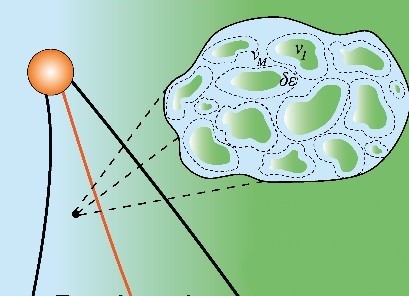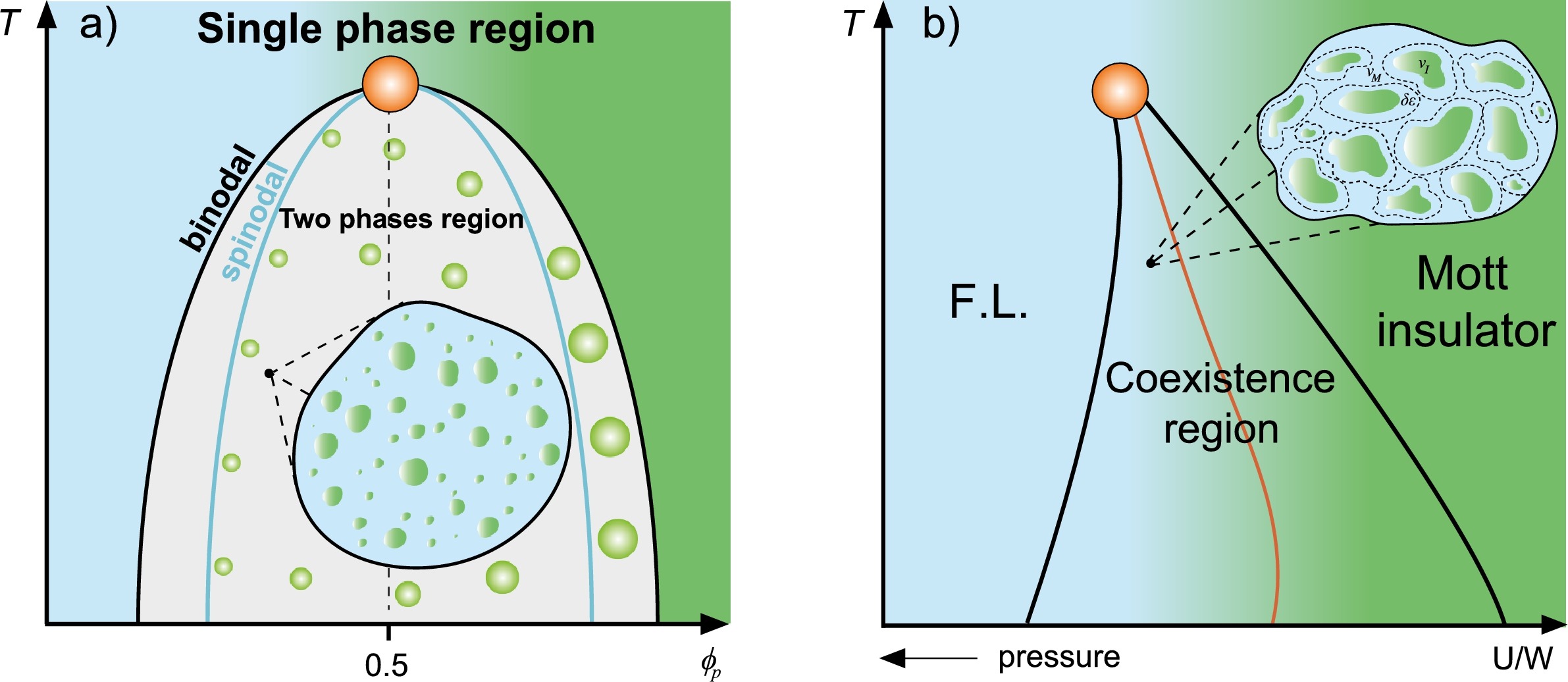

See the complete figure at the end of this article
Researchers at São Paulo State University (UNESP) used concepts of condensed matter physics to describe phase separation. Their findings can have applications in the treatment of diseases.
Researchers at São Paulo State University (UNESP) used concepts of condensed matter physics to describe phase separation. Their findings can have applications in the treatment of diseases.

See the complete figure at the end of this article
By José Tadeu Arantes | Agência FAPESP – In physics, a system composed of two substances can be modeled in accordance with classical mixture theory, which considers the fraction corresponding to each constituent and the interactions among constituents. Examples include the coexistence of high- and low-density phases in supercooled water, and the coexistence of metal puddles in an insulating matrix in the Mott metal-insulator transition (see graphical representation and detailed explanation in first figure below).
Motivated by this kind of consideration, researchers at São Paulo State University (UNESP) in Rio Claro, Brazil, used concepts of condensed matter physics to describe protein compartmentalization in cells and proposed a cellular Griffiths-like phase in direct analogy to the canonical magnetic Griffiths phase. An article on the study is published in the journal Heliyon. The last author and PI is Mariano de Souza, a professor at the Institute of Geosciences and Exact Sciences (IGCE-UNESP), and the first author is Lucas Squillante, a PhD candidate at the same university.
“In the magnetic Griffiths phase, magnetized or non-magnetized regions emerge in paramagnetic or ferromagnetic matrices respectively, giving rise to a significant reduction in the dynamics of the systems. These so-called ‘rare regions’ emerge in random fashion. In previous work, we explored the electronic Griffiths-like phase at the verge of the Mott metal-insulator transition. In this study we focused on the protein droplets formed inside cells as ‘rare regions’, in direct analogy with the magnetic Griffiths phase,” Souza said (read more at: agencia.fapesp.br/35249).
Production of proteins inside a cell can reach a threshold that gives rise to liquid-liquid phase separation and compartmentalization of proteins in the form of droplets. “Using thermodynamics tools such as the Grüneisen parameter, the Flory-Huggins model and the Avramov-Casalini model, we show that cellular dynamics is dramatically reduced in the vicinity of the binodal line that determines phase separation, and also for an equivalent protein/solvent concentration, giving rise to a Griffiths-like cellular phase,” Souza said (see graphical representation in second figure below).
The study also proposes that the Griffiths-like cellular phase is associated with the origin of life and the emergence of primordial organisms, in accordance with the classical theory formulated by Russian biologist and biochemist Aleksandr Oparin (1894-1980) in the 1930s, since only coacervates (droplets of organic molecules clustering in an aqueous solution) with slow dynamics survived and evolved.
“This in turn may be linked to the fundamental role played by homochirality in the evolution of life,” Souza said. Chirality is the property of an object or molecule which means it cannot be superimposed on its mirror image. Human hands are chiral, for example. Homochirality is the predominance of a single chirality in molecules of a biological system.
The researchers demonstrate in the study that an increase in protein diffusion time occurs concomitantly with a reduction in stochastic fluctuations in the cell, which in turn is key to optimizing gene expression. The study offers an alternative approach to investigating the dynamics of protein compartmentalization, which may also be applicable to other biological systems.
“The fundamental role played by liquid-liquid phase separation in the development and treatment of diseases is widely discussed in the literature, especially with regard to tumorigenesis. The idea is that proteins encoded by genes associated with such diseases can be compartmentalized and that this affects their role in cell mutation,” said Marcos Minicucci, a professor of clinical medicine at UNESP Botucatu and a co-author of the article.
Other examples of the role played by phase separation include cataract (where phase separation in the retina can cause visual impairment), neurodegenerative diseases, and even COVID-19 (where coacervation of the SARS-CoV-2 N protein can suppress the innate immune response to the virus). It has recently been reported that the phase separation associated with ferroptosis suppressing protein 1 (FSP1) can be used in an effective therapeutic intervention against cancer.
“Liquid-liquid phase separation affects each disease differently, and protein droplet formation may or may not be beneficial. The Griffiths-like cellular phase we’re proposing can have a significant impact in managing and even treating diseases,” Minicucci said. The study conducted by Souza’s group demonstrates the importance of interdisciplinarity in fundamental science projects.
The other co-authors besides Squillante, Minicucci and Souza are Antonio Seridonio (UNESP Ilha Solteira), Roberto Lagos-Monaco (UNESP Rio Claro), Aniekan Magnus Ukpong (University of KwaZulu-Natal, Pietermaritzburg, South Africa), Luciano Ricco (University of Iceland), and Isys Mello, a PhD candidate supervised by Souza.
The study was supported by FAPESP via two projects (11/22050-4 and 18/09413-0).
The article “Cellular Griffiths-like phase” is at: www.sciencedirect.com/science/article/pii/S2405844024106536.

Comparison between protein compartmentalization within the cell (a) and the coexistence of metal puddles in an insulant matrix (b).
a) Schematic representation of the temperature T versus protein concentration ϕp phase diagram depicting the single and the two phases regions separated by the binodal line, which is governed by a critical point (orange color). The spinodal line is also depicted (blue line). In the two-phases region, protein droplets emerge within the cell. A cell containing various protein droplets (green circles) embedded in a solvent (blue color) is schematically depicted zoomed in within the two-phases region. The blue and green color gradient background represents the increasing of proteins inside the cell.
b) Schematic representation of the T versus U/W∝℘−1 phase diagram of the molecular system κ-(BEDT-TTF)2Cu2(CN)3, where U is the on-site Coulomb repulsion, W the bandwidth, and ℘ pressure, showing the coexistence region between Fermi-liquid F.L. (metal) and Mott insulator. The finite-T critical endpoint is depicted (orange color). The blue and green background gradient represents the metallic and Mott insulating phases, respectively. In the coexistence region, insulating puddles (green) embedded in a metallic matrix (blue background) with their corresponding volumes, namely, vM and vI, are depicted. The interaction parameter δε is indicated.

Schematic representation of the cellular Griffiths-like phase (CGLP). In the single-phase region, the proteins (green spheres) diffuse in the solvent matrix with a characteristic diffusion time τ0. As ϕp is increased and the vicinity of the binodal line is achieved, there is a phase separation and protein droplets emerge and start to grow, so that kin > kout. The diffusion time τ → ∞ and the CGLP is achieved. Also, at ϕp = 0.5 the CGLP sets in, where kin, kout → 0 and τ → ∞
Illustrations and text: Heliyon
Republish
The Agency FAPESP licenses news via Creative Commons (CC-BY-NC-ND) so that they can be republished free of charge and in a simple way by other digital or printed vehicles. Agência FAPESP must be credited as the source of the content being republished and the name of the reporter (if any) must be attributed. Using the HMTL button below allows compliance with these rules, detailed in Digital Republishing Policy FAPESP.





